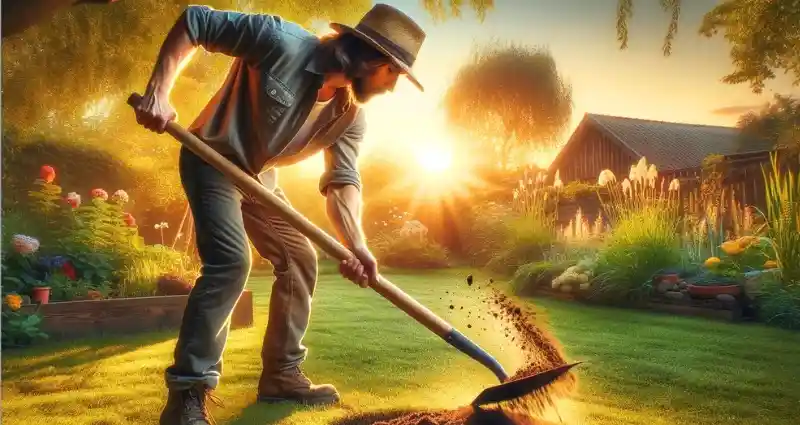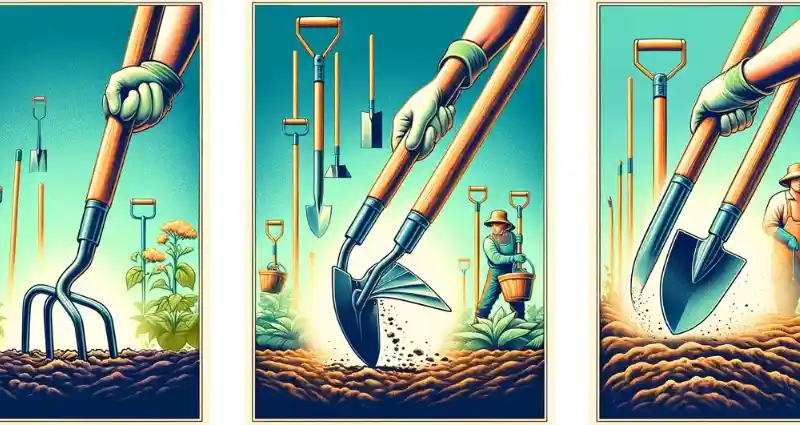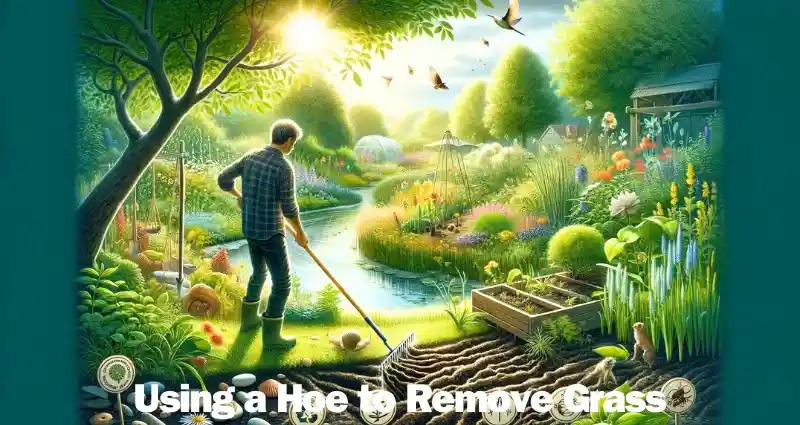Using a Hoe to Remove Grass: Swift & Eco-Friendly Tips
Using a hoe to remove grass involves slicing into the soil and undercutting roots. Tilt the tool and push forward to sever the grass from the ground.
Removing grass with a hoe is a straightforward method that gardeners and homeowners commonly use to clear land for new plantings or to control weed growth. This manual technique allows for precision and can be particularly effective in smaller areas.
A sharp hoe blade slices through the soil, cutting the roots of the grass, making it easier to remove the top layer of vegetation. It’s a cost-effective and environmentally friendly approach compared to chemical treatments, giving users the satisfaction of physical work and immediate results.
By mastering the use of a hoe, individuals can maintain their outdoor spaces with minimal tool investment and avoid the use of harmful herbicides.
No products found.
Grass Removal With A Hoe: A Primer

Tackling weeds and unwanted grass in your garden can be a daunting task. A simple tool, the humble hoe, emerges as a champion of grass removal. This traditional method offers efficiency and precision in maintaining a clean and healthy garden. Let’s delve into how a hoe can be your garden’s best friend.
Why Opt For Hoeing?
Using a hoe for removing grass comes with multiple benefits. It’s both cost-effective and eco-friendly. The method requires no harmful chemicals, safeguarding your garden’s ecosystem. Additionally, hoeing provides a physical workout, contributing to your overall health.
- Minimizes soil disturbance
- Encourages growth of beneficial organisms
- Reduces weed competitors
Types Of Hoes For The Task
Picking the right hoe for the task depends on the type of grass and soil conditions. Different designs cater to varying gardening needs.
| Type of Hoe | Best For |
|---|---|
| Draw Hoe | Chopping and moving soil |
| Dutch Hoe | Sliding under the soil surface |
| Stirrup Hoe | Cutting weeds just below the soil |
| Collinear Hoe | Light cultivation and weeding |
Your choice should factor in the blade width, handle length, and the area you need to cover.
Preparing For The Weed War
When grass invades your garden beds, it’s time to declare a weed war. A hoe becomes your trusty weapon. Winning this battle requires preparation. Safety, proper timing, and choosing the right day are key to victory.
Safety First: Gear And Techniques
Gardening with a hoe demands safety. Protect yourself before confronting those pesky weeds. Here’s how:
- Gloves save hands from blisters.
- Long sleeves and pants ward off scrapes.
- Sunscreen and hats keep sunburns at bay.
- Safety glasses shield eyes from flying debris.
Hoe with care:
- Stand firm, avoiding strain on your back.
- Use a shallow angle to skim the surface, cutting weed roots.
- After use, clean your hoe to prevent rust.
Choosing The Right Day: Weather And Soil Conditions
The day you choose to hoe makes a difference.
| Weather | Soil Condition | Outcome |
|---|---|---|
| Cloudy | Moist | Effortless weeding |
| Sunny | Dry | Weeds wither |
| Rainy | Wet | Challenging hoeing |
Check the forecast, plan for a cloudy or sunny day, and feel the soil. It should be dry, not wet. This makes hoeing a breeze and weeds less likely to regrow.
The Art Of Hoeing

Mastering the use of a hoe transforms tough tasks into simpler ones.
With a sleek metal blade and a sturdy handle, a hoe is not just a tool—it’s a gardener’s ally.
Whether battling unwanted grass or cultivating soil, the art of hoeing speaks to precision and care.
Let’s dig into techniques that elevate your hoe experience from novice strokes to expert sweeps.
Hoeing Techniques: From Novice To Expert
Starting out, the goal is to minimize effort and maximize impact. Here’s how:
- Stand upright to maintain balance and reduce back strain.
- Grip firmly at the end and halfway up the handle for control.
- Chop down and pull to slice through grass roots.
- Use a push-pull motion to disturb the soil surface and uproot weeds.
- Sharpen the blade for effortless cutting.
Advancing technique involves wrist finesse and rhythm.
Use short, quick strokes for precise weeding between plants. With practice, hoeing becomes a seamless, almost dance-like motion.
Tips For Effective And Efficient Hoe Use
These tips ensure your hoeing is not just effective, but efficient too.
- Choose the right hoe type for your task—Dutch, draw, or stirrup.
- Maintain a sharpened blade to make cutting smoother.
- Work during dry conditions to prevent soil sticking.
- Remove and compost weeds after hoeing to clear the area.
- Regularly clean your hoe to prevent rust and soil-borne diseases.
Remember, consistent practice is key to mastering any skill, and hoeing is no exception.
| Task | Hoe Type | Technique |
|---|---|---|
| Weeding | Stirrup Hoe | Pull lightly at the soil surface |
| Edging | Dutch Hoe | Push along the bed edges |
| Cultivating | Draw Hoe | Chop to aerate soil |
Eco-friendly Advantages Of Hoeing
Removing grass with a hoe stands out as an eco-friendly gardening practice. Unlike other invasive methods, hoeing nurtures both the soil and the environment. Gardeners who choose this traditional tool take an active role in supporting a healthier planet. Below, we delve into the reasons why hoeing is the green thumb’s choice for maintaining a vibrant garden space.
Chemical-free Weeding: Benefits For The Earth
Hoeing replaces the need for harmful chemicals. It eliminates weeds without contaminating soil and water. Here are the key benefits:
- Preserves soil quality: No toxic substances mean healthier soil.
- Protects local wildlife: Keeping the ecosystem safe for insects and animals.
- Safeguards water sources: Clean groundwater without chemical runoff.
Encouraging Biodiversity In Your Garden
Hoeing creates a haven for diverse plant and animal life. Biodiversity thrives under the care of conscientious gardeners.
| Biodiversity Factor | Impact of Hoeing |
|---|---|
| Soil Organisms | Improves habitat for worms and microorganisms. |
| Plants | Reduced competition allows varied species to flourish. |
| Insects | Provides a safe space for pollinators and beneficial predators. |
Post-hoeing Practices

Post-hoeing practices ensure a clean, enriched garden bed after the tough task of removing grass with a hoe. Proper disposal and soil nurturing set the stage for a thriving garden. Let’s delve into the two critical steps to follow once the grass is gone.
Disposal Of Removed Grass
Removing grass clumps from the garden helps detour pests and diseases. Here are the steps for eco-friendly disposal:
- Composting: Turn grass into nutrient-rich compost.
- Green Waste: Utilize council green bins if available.
- Mulching: Dry and use grass as mulch for other plants.
Soil Enrichment And Recovery
The soil needs love after hoeing. Focus on these areas:
- Aeration: Loosen the soil to help roots grow.
- Nutrient Boost: Add compost or organic fertilizers.
- Watering: Keep the soil moist to encourage recovery.
Maintaining Your Tools And Garden

Gardening success often hinges on using the right tools in the right way. A hoe is a gardener’s ally in battling weeds and shaping soil, but its efficiency is only as good as your tool’s condition and your gardening methods. Properly maintained tools ensure more effortless garden work and sustainable practices.
Hoe Care: Keeping Your Tool In Top Shape
Regular maintenance of your hoe keeps it sharp and efficient. Here’s how you can care for your tool:
- Clean after every use to remove soil and grass
- Sharpen the edge with a file for a cleaner cut
- Oil the metal parts to prevent rust
- Inspect for any damage before and after use
- Store in a dry place to avoid moisture damage
Sustainable Gardening Habits Beyond Hoeing
Sustainable practices enhance your garden’s health and the environment. Consider these habits:
- Compost your garden waste.
Turn grass clippings into nutrient-rich compost.
- Water wisely by using a drip irrigation system.
It reduces water usage and reaches plant roots directly.
- Choose native plants that require less water and care.
They thrive in your local climate and support local wildlife.
- Cultivate soil health with organic matter.
Add compost or manure to nourish your soil.
- Rotate crops each season.
This practice prevents soil depletion and pest build-up.
Frequently Asked Questions Of Using A Hoe To Remove Grass
How Does A Hoe Remove Grass Efficiently?
A hoe removes grass by cutting the plant at its base. It slides just beneath the soil surface. With a sharp push or pull, it severs roots. This halts grass growth. The tool works best on loose or moist soil.
It’s ideal for garden weeding.
Can You Remove Grass With A Hoe Manually?
Yes, you can manually remove grass with a hoe. It involves physically chopping and pushing through the soil to cut roots. This action undermines and pulls out the grass. It’s labor-intensive yet effective. Best done in small patches and for garden tidying.
What Is The Best Hoe Type For Grass Removal?
The best hoe for grass removal is the stirrup or loop hoe. Its sharp, double-sided blade cuts with a push-pull motion. This reduces effort while efficiently slicing through grass roots. It’s also user-friendly and minimizes soil disturbance in your garden.
When Is The Optimal Time To Use A Hoe On Grass?
The optimal time to use a hoe on grass is early morning or after rainfall. The moist soil allows the hoe to slice through with less resistance. It makes grass removal easier. Dry, hardened soil can be more challenging to work with.
Conclusion
Thank you for joining us on the journey through effective grass removal with a hoe. As we’ve shared, this tool can be your garden’s best friend, offering a simple, eco-friendly way to maintain a pristine yard. Embrace the time-tested tradition of hoeing, and revel in the satisfaction of a well-manicured outdoor space.
Happy gardening!


